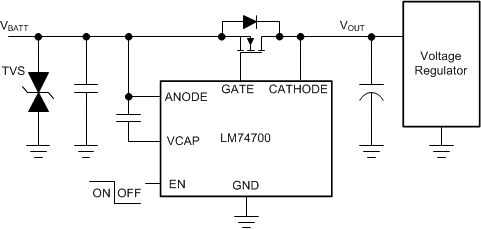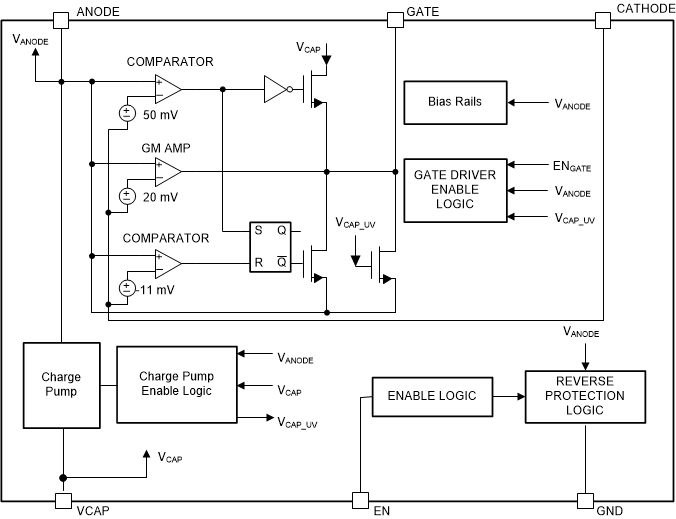SLVAE57B February 2021 – October 2021 LM5050-1 , LM5050-2 , LM5051 , LM66100 , LM74202-Q1 , LM74500-Q1 , LM74610-Q1 , LM74700-Q1 , LM74720-Q1 , LM74721-Q1 , LM74722-Q1 , LM7480-Q1 , LM7481-Q1 , LM76202-Q1 , SM74611 , TPS2410 , TPS2411 , TPS2412 , TPS2413 , TPS2419
- Trademarks
- 1 Introduction
- 2 Reverse Battery Protection
- 3 ORing Power Supplies
- 4 Reverse Battery Protection using MOSFETs
- 5 Reverse Polarity Protection vs Reverse Current Blocking
- 6 What is an Ideal Diode Controller?
- 7 Automotive Transient protection with Ideal Diode Controllers
- 8 ORing Power Supplies with Ideal Diode Controllers
- 9 Integrated Ideal Diode Solution
- 10Summary
- 11References
- 12Revision History
6.1 Linear Regulation Control Vs Hysteretic ON/OFF Control
In linear regulation control, forward voltage of the MOSFET is regulated by controlling the gate voltage based on the load current. Linear regulation is achieved by controlling the gate voltage and thereby varying the RDS(ON) of the MOSFET based on load current. At nominal load currents, gate-source voltage is maintained above the MOSFETs Vth and at lower load currents, gate-source voltage is maintained close to MOSFETs Vth with increased RDS(ON). At higher load currents, gate-source voltage is parked close to the maximum gate drive voltage, operating close to lowest possible RDS(ON). Choosing the MOSFET based on the operating power requirements helps maintain the MOSFET under regulation during most of the load conditions. Linear regulation of the forward voltage along with a fast reverse current blocking helps ensure zero DC current flows back into the input. Further, it also minimizes the peak reverse current during a input supply failure, input supply transients or input supply droop.
In Hysteretic ON/OFF control, MOSFET is fully turned ON when the forward turn ON comparator threshold VFWD_ON is exceeded and turned OFF when the reverse comparator threshold VREV_OFF is reached. When the MOSFET is ON, the gate is fully enhanced and the gate-source voltage is not controlled depending on the load current. MOSFET is turned off when the reverse current reaches VREV_OFF / RDS(ON). Note that the MOSFET cannot turn OFF if a reverse current less than VREV_OFF / RDS(ON) flows. The reverse turn off threshold VREV_OFF is fixed negative value or programmable allowing small positive value. In ideal diode controllers where the reverse comparator threshold is programmable and can be set to a small positive value, the DC reverse current can be completely blocked. Additionally, setting the reverse comparator threshold to a small positive value can require a minimum forward load current VREV_OFF / RDS(ON) to turn ON the MOSFET. If a minimum forward load current is not maintained, MOSFET can turn ON/OFF continuously leading to sustained oscillation of the gate voltage.
| IDEAL DIODE CONTROLLER | OPERATING RANGE (ABSOLUTE MAXIMUM RATINGS) | LINEAR REGULATION CONTROL | HYSTERETIC ON/OFF CONTROL |
|---|---|---|---|
| LM74700-Q1 | ±65 V | Yes | No |
| LM74610-Q1 | ±45 V | No | Yes |
| LM5050-1 and LM5050-1-Q1 | ±100 V | Yes | No |
| LM5050-2 | ±100 V | Yes | No |
| TPS2410 and TPS2412 | ±18 V | Yes | No |
| TPS2411 and TPS2413 | ±18 V | No | Yes |
| TPS2419 | ±18 V | No | Yes |
| LM74701-Q1 | ±65 V | Yes | No |
| LM7472x-Q1 | ±70 V | Yes | No |
| LM74800-Q1 and LM74810-Q1 | ±70 V | Yes | No |
| LM74801-Q1 | ±70 V | No | Yes |
A typical application schematic in Figure 6-1 shows the LM74700-Q1 ideal diode controller driving an external N-Channel MOSFET. MOSFET is connected with its source tied to the input so that body diode blocks the reverse current when turned OFF. The charge pump capacitor is connected between Anode and VCAP to provide sufficient gate drive voltage to turn on the MOSFET. EN pin is used to turn the MOSFET ON, providing regulated low forward drop across anode to cathode during normal operation. Pulling down the EN pin turns OFF the MOSFET and the controller goes into low shutdown current mode. When the MOSFET is turned OFF, the load can still draw power through body diode of the MOSFET.
 Figure 6-1 Ideal Diode Controller -
Typical Application Schematic
Figure 6-1 Ideal Diode Controller -
Typical Application SchematicThis section discusses the key performance features of the LM74700-Q1 using the functional block diagram shown in Figure 6-2. Ideal diode controllers have an internal charge pump to drive the gate of MOSFET sufficiently higher than anode during normal operation, forward comparator to turn ON and reverse current comparator to turn OFF when reverse current is detected, allowing the MOSFET body diode to block reverse DC current completely.
 Figure 6-2 Block Diagram of Ideal Diode
Controller
Figure 6-2 Block Diagram of Ideal Diode
Controller